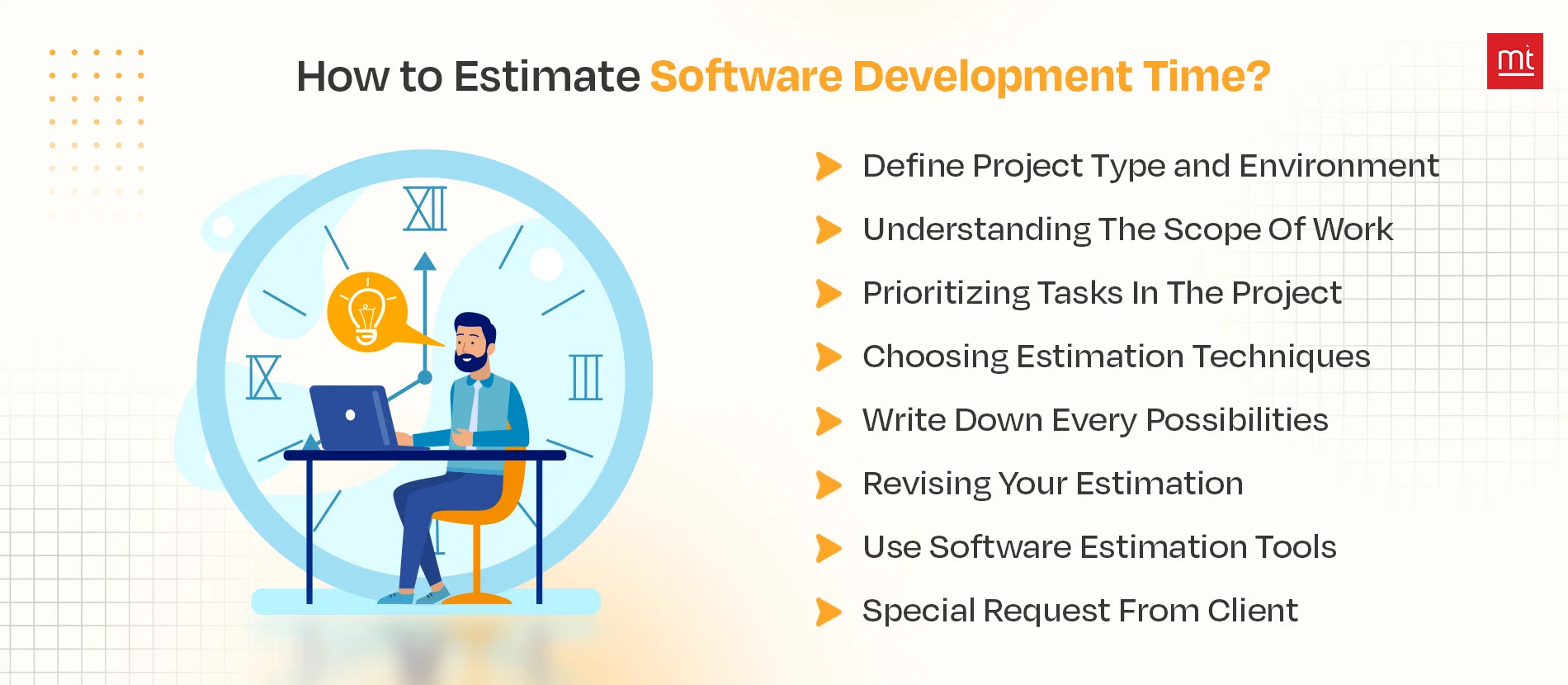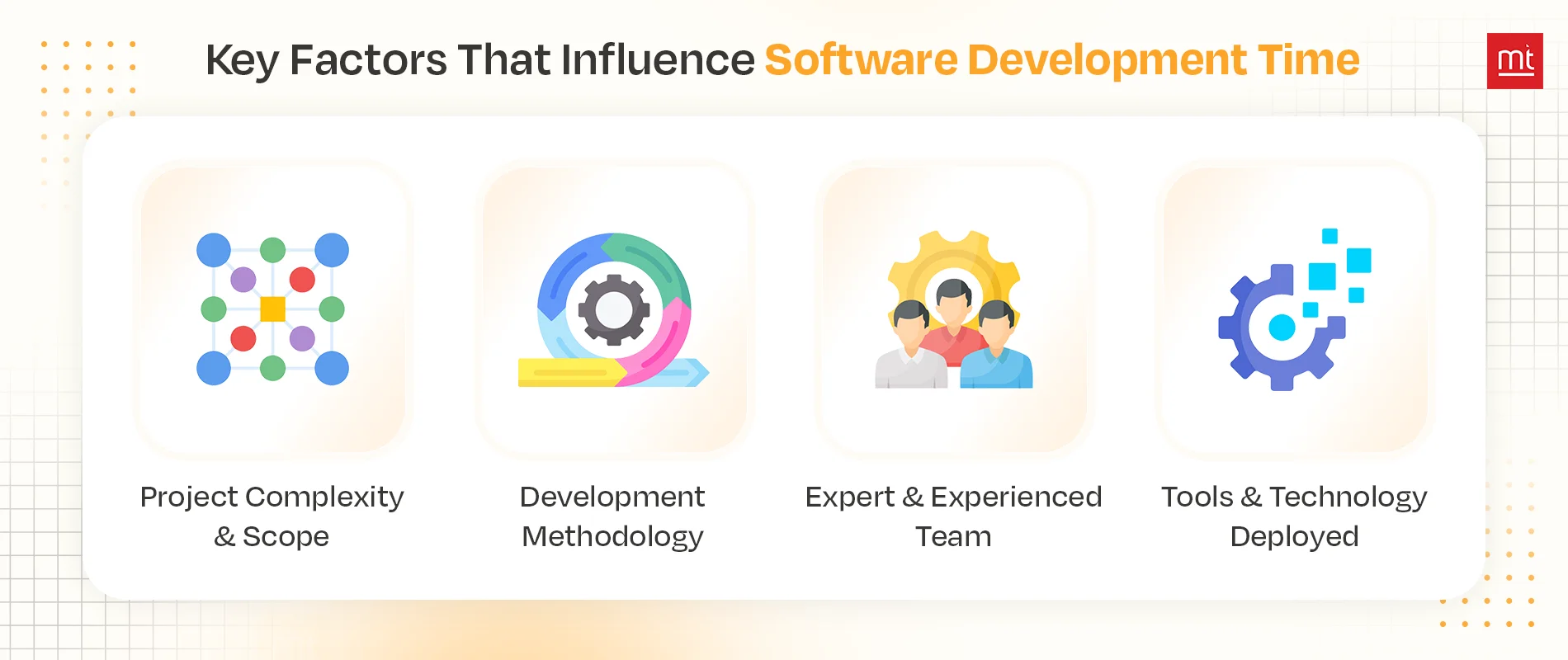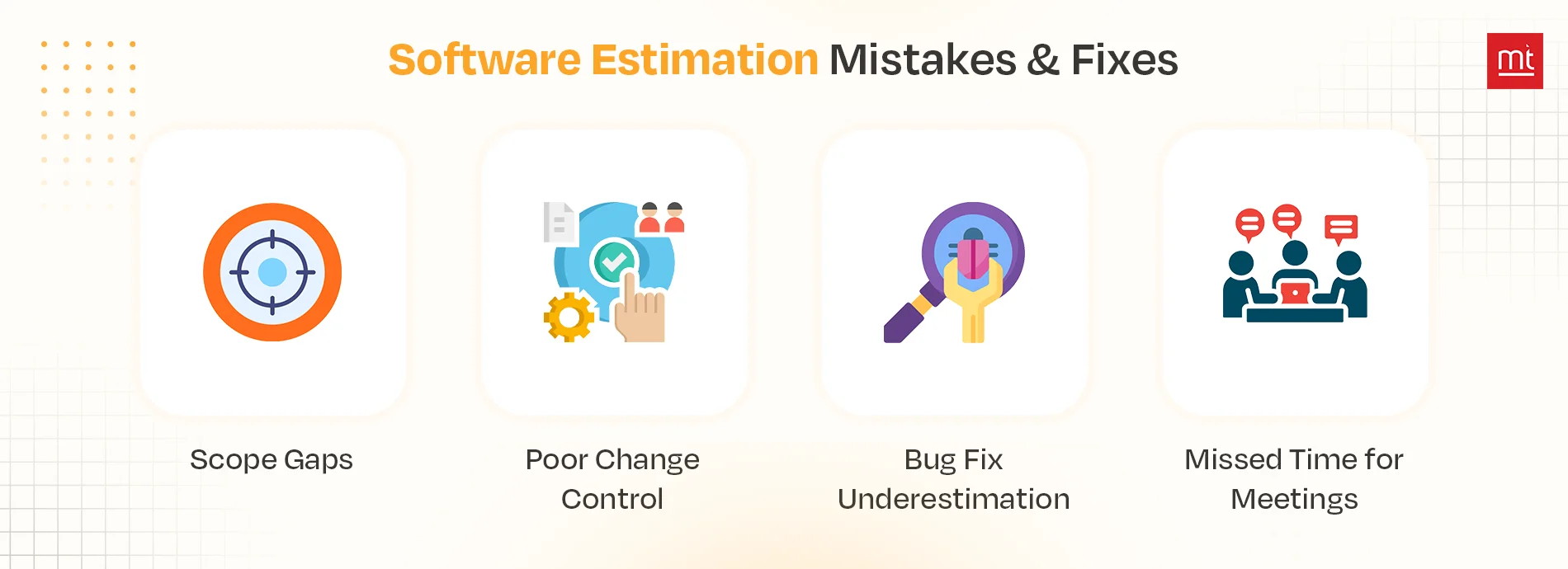Key Takeaways:
Software time estimation is important in order to deliver the project with perfection on a suitable time. This blog breaks down the what, why, and how of software development time estimation.
- Learn what software time estimation really means
- Understand why it’s often harder than expected
- Discover practical steps and tools to estimate better
- Explore techniques like Bottom-Up and PERT
- Avoid common mistakes and get expert help from ManekTech
Delays in a project are the biggest red flags that can impact your years of hard work and reputation. Software development is the highly-transformative and fastest-growing industry among all, Research also says that it is expected to reach up to $1,450.87 billion by 2031 due to increased demand for AI, automation, low-code, no-code platforms, and much more. And so the competition will also grow.
Recent studies show that 60% of software projects get delayed due to poor time estimation. That’s why software development estimation is crucial—it helps you plan better, manage resources wisely, control budgets, build trust, and deliver on time.
Every software project starts with a question: How long will it take? And this doesn't work on guessing. In this blog, we’ll walk you through the basics of software development time estimation, along with useful tools, proven techniques, and common challenges to avoid.
What Is Software Development Estimation?
Software development estimation is the process of predicting the time, effort, and cost required to complete a software project. It helps teams plan tasks, allocate resources, set timelines, and manage budgets effectively.
Estimation is usually based on the project’s size, complexity, technology used, and team experience. Accurate estimation reduces the risk of delays, overspending, and missed goals. It plays a key role in making sure a project runs smoothly and meets both client expectations and business objectives.
Why Are Software Estimates So Hard?
Software project estimation is hard because each project is unique, with different requirements, technologies, and challenges. Currently, the technologies and user demands are constantly changing, which can fluctuate the budget and timeline.
Estimation is prepared by requirements and scope defined by the client, If the client is unclear about what he/she wants, this can make estimation inaccurate.
Why is Software Project Estimation Important?
Software project estimation is the backbone of your project lifecycle. Here is why it's important:
- It helps plan the project properly from start to finish.
- It gives a clear idea of how much time, effort, and money is needed.
- It allows teams to set realistic deadlines.
- It prevents overspending and delays.
- It makes it easier to assign the right people and resources.
- It builds trust with clients by setting clear expectations rather than making fake promises.
- You can deliver the project on time and within budget.
How to Estimate Software Development Time?
Follow the below steps to get a realistic estimate and achieve accurate software project estimation within a budget and timeline.

1. Define Project Type and Environment
An accurate estimate is dependent on how clearly the requirements are mentioned. Consider things like:
- Project features, functionality, and goals.
- Problem statements and client’s expectations.
- Tech stack, user base, and performance needs.
- Clear all external needs and third-party integrations if required
- Also, ask what are undeniable features and what are less priority. Study the audience who are gonna use this software.
Pro tip: Make a document of each and every point and prepare a well-defined requirement. This will help you to understand all sides of software and prepare estimation without a doubt.
2. Understanding The Scope Of Work
Clearly define the working of each feature and functionality and explain how you expect to work it. It involves discussing with clients to gather detailed requirements, creating user stories, and identifying what’s in-scope and out-of-scope. This step ensures the team knows exactly what needs to be built, avoids misunderstandings later, and forms the base for accurate time and software development cost.
3. Prioritizing Tasks In The Project
Once the project scope and requirements are clear, prepare a roadmap and sequence of each task to execute the project in a well-organized manner. This helps you allocate time efficiently, focus on core features first, and plan the work sequence. Prioritize the important features first and assign the work according to the proficiency of the team. You can make minor adjustments later.
4. Choosing Estimation Techniques
Choose the suitable estimation technique according to project complexity, team experience, and available project data because each technique works differently based on the project size, team involvement, and experience.
This will help you break down work logically and predict how long each part of the development will take.
5. Write Down Every Possibilities
There are an infinite number of ways to approach each project. The exact nature of this might differ, based on the adaptation defined, as well as the applied tools and methodology. Work with your mind, then ask each team member to make a list of possibilities.
The practice of writing all of the possibilities will allow you to assume the risks and challenges that you are likely to encounter for a given type of project.
Add testing time, deployment, bug fixes, or third parties.
6. Revising Your Estimation
As humans, we always get last-minute ideas. Plans change, and it's completely normal. Hence, revise your estimate multiple times until there is less chance of document changes.
Be open to the latest ideas and adapt to the latest trends.
Make sure to keep teams and stakeholders updated on the latest revision or any change to avoid surprises in the future.
7. Use Software Estimation Tools
Visual representations are easy to remember and understand. Use tools like PERT charts, Work Breakdown Structures, or backlog trackers to explain the modules and time for creating each. These tools help to track the task and calculate dependencies and time.
8. Special Request From Client
Clients often make specific requests, such as introducing a new feature, integrating with a third-party service, or following specific industry rules (compliance). These requests may not seem large, but they require additional time for design, development, and testing.
So keep this in your first plan for giving reasonable estimates.
Key Factors That Influence Software Development Time
The following things can add time to your project estimation, even if you follow a systematic approach.

#1. Project Complexity and Scope
Complex and long projects require more features, functionalities, and ultimately more planning. The number of features, integrations, and types of users can complicate timelines by a lot. If you increase the scope, you also increase the effort required — which of course is reflected in the time estimate, and might involve additional resources.
#2. Development Methodology (Agile vs. Waterfall)
Agile allows flexibility and continuous feedback, often leading to evolving requirements and rework, which can affect timelines. Waterfall follows a fixed plan but lacks adaptability. Your chosen methodology determines how changes are handled, how progress is tracked, and ultimately, how accurately you can estimate development time.
#3. Experience and Expertise of the Development Team
An expert and seasoned team could work more effectively, troubleshoot quickly, and develop better-quality code. On the other hand, a team with less experience may struggle to learn tasks or encounter technical roadblocks. The speed and accuracy of the project’s progress are heavily dependent on the capabilities of the team.
#4. Tools & Technology Deployed
Whatever you are using to build — frameworks, languages, third-party services — they can either speed up development or slow it down. Breaking out the latest tech may take time to learn how to use while using older tools can cause you to be less efficient. The right tech stack can help in easy workflows and will allow for better estimates when it comes to timelines.
Software Development Estimation Tools
Software development estimation can be done using the following tools. Each tool’s usefulness depends on project complexity, team, and length.

1. Work Breakdown Structure (WBS)
WBS is a project management tool where the entire project is divided into small and manageable tasks. Each task is estimated separately to find time for each module. After that, the entire module time is added to give an accurate estimation.
It’s ideal for large, structured projects where deliverables are well-defined. WBS improves clarity, allows better task assignment, and helps track progress at every stage of the development cycle.
2. PERT Chart
PERT means Program Evaluation and Review Technique. It is a visual project management tool that helps you to schedule and organize the project tasks within the team.
As project tasks are represented visually with network diagrams and arrows for dependencies, it is easy to understand the project flow and assume the duration of time.
It estimates time-based on optimistic, pessimistic, and most likely scenarios. Overall, it's great for complex, time-sensitive projects because it helps to identify potential delays earlier.
3. Product Backlog
A product backlog is a document that contains a list of user stories, bugs, sprint planning, scope management, stakeholder communication, story points, affinity mapping, relative estimation, and many more things.
This document is constantly updated to calculate the time taken for each item to predict the accurate delivery time.
Software Development Estimation Techniques
Every project is different, so you need to choose suitable software development estimation techniques which match your project’s size, complexity, and style.

1. Bottom-Up Estimation
In bottom-up estimation, the complete project is broken down into small, individual tasks, and then each task is estimated separately. These task-level estimates are summed to determine the total time. It’s extremely detailed and accurate, particularly for complex projects with clearly defined specifications. It is time-consuming but provides a clear picture, and helps to plan each step from the beginning.
2. Top-Down Estimation
Estimation in the top-down technique begins with a higher level of details first and then moves the scales to finer details. Then it allocates that time among tasks. It’s faster than Bottom-Up but less accurate. You can use this for early-stage planning or smaller projects where full details are not yet available.
It will give you an approximation to guide timelines and budgets.
3. Parametric Estimation
Parametric Estimation is the method of finding project completion time using data and formulas. For example, the number of lines of code or the number of screens are used to calculate elapsed hours. It is necessary to use already-known project values for the present project. This is a very effective technique where the project is made up of components that are the same and can be measured.
It provides consistency, speeds up estimates, and works well when you have historical data and standard project patterns.
4. Three-Point Estimating
This technique considers three scenarios: optimistic (best-case), pessimistic (worst-case), and most likely. The average of these gives a balanced estimate. It helps manage uncertainty and prepare for risk. Three-point estimating is best for medium to complex projects where time can vary greatly. It improves accuracy and prepares teams for both delays and fast progress.
5. Planning Poker
Planning Poker is a group-oriented Agile estimating strategy. A team makes use of cards during a meeting to calculate task complexity, discuss differences, and eventually come to an agreement. Team members are encouraged to work collaboratively, get multiple perspectives, and avoid one-sided opinions.
This particular strategy is liked by many people, is time-effective, and is efficient for planning sprints in Agile projects, when tasks are still in progress.
6. Analogous Estimation
Analogous Estimation is a technique that is used with the help of historical data from similar projects to the current ones to predict time. This method saves time and money but provides a more general type of forecast. The use of this technique is recommended when the project is at an early stage or the information about the project is quite limited.
It helps in establishing initial expectations and is most suitable for projects that are of the same scope, size, or complexity as those completed earlier.
Common Software Development Estimation Mistakes and How to Avoid Them

1. Missing Elements from the Project Scope
To get the right estimation of the time, every requirement and module is equally important hence overlooking one specific part can cause delay and rush that may lead to missing other things.
This can be avoided by involving stakeholders from the beginning with you. Create a detailed document and discuss it together, this will create a serious and disciplinary approach to get the estimation process on the right track.
2. Improper Management of Change Requests
If you forget to update the change request by the client in the documents, this can result in a wrong estimation. It's important to be highly active during the estimation process update the minor changes and discuss the result of this change openly with the client. Talk about whether this change will extend the timeline or impact the project cycle.
3. Inaccurate Estimation of Bug-fixing Tasks
Never assume fixing bugs will take less time so you can fix them all together in the last. Bug fixing can vary according to its type and complexity. So always add a buffer time for testing and fixes in your estimate, based on previous project experience and standard QA practices.
4. Estimating Time for Meetings and Communication
Never ignore the time spent on meetings and communication because you can't assume how much time you need to discuss with your team members. Clarity in the project is everything so also consider the time spent on meetings, check-ins, client reviews, and internal discussions to prevent unexpected time drains.
How Can ManekTech Help You With Software Development Time Estimation?
Manektech is a top-notch software development company with a strong reputation for 14 years in the industry. We have handled a lot of software projects in our professional journey and have a great grip on software project estimation. As we are result-oriented and concerned more about quality, we only trust advanced tools and proven methodologies to provide accurate time estimation.
Our team breaks down your project into measurable tasks, analyzes risks, and considers various real-world scenarios to provide you the realistic forecasts. Our extensive experience and tailored business strategies help to plan better, reduce uncertainties, and deliver the projects before the timeline.
If you’re starting a new project and want clarity from day one, we can create custom estimation solutions based on project needs. We analyze every detail to give you a realistic timeline and resource plan, contact ManekTech now for an expert estimation.
Wrapping Up
So, now you might know how to estimate time for software development. Hope this article helped you learn about various types of estimation techniques, useful estimation tools, common mistakes, and many useful things. Estimating the software development timeline is the foundation of a great project that helps you in smoother development, and results in fewer surprises, and happier clients. By learning to estimate wisely and avoid common pitfalls, you can reduce delays and budget overruns. Remember, it’s not about guessing—it’s about informed planning.
FAQs
1. How can Software Projects be Estimated?
Software projects can be estimated by using techniques like bottom-up, top-down, three-point, parametric, and analog estimation. Every estimation method begins with defining the project requirements scope. Then, estimators analyze it and break tasks into manageable parts, prepare the timeline, and schedule how the task should get completed in sequence. The next step is analyzing complexity and determining the resources and tools required for the project.
Other than this, team experience, technologies used, and methodology (Agile or Waterfall) are also important to find accurate time and cost estimates.
2. What is the Need for Software Project Estimation?
Software project estimation is very important to execute the project in an organized manner and to avoid troubles during and after the project. It helps to set realistic expectations and a timeline, allocate resources effectively, plan budgets, and reduce project risks.
3. What are the Steps Involved in Software Project Estimation?
Software project estimation requires the following steps:
- Understand what kind of project it is and the environment it will run in.
- Break down tasks into small parts and assign to suitable experts.
- Choose suitable estimation techniques.
- Write down all assumptions and estimate updates, estimation tools, and other things.
Pro tip: Be flexible throughout the development cycle in case the client asks for any change at any stage.
4. Who Defines the Scope and Budget of a Project? How does it Happen?
The project scope and budget are decided by the project manager, client, stakeholders, and development team. It is a collaborative approach that includes various things like requirement gathering and feasibility analysis, setting priorities, budgets, estimates, and much more.
Subscribe to Our Newsletter!
Join us to stay updated with our latest blog updates, marketing tips, service tips, trends, news and announcements!






![Top 10 Software Development Companies in USA [Updated 2025]](https://www.manektech.com/storage/blog/image/1746450897.webp)















